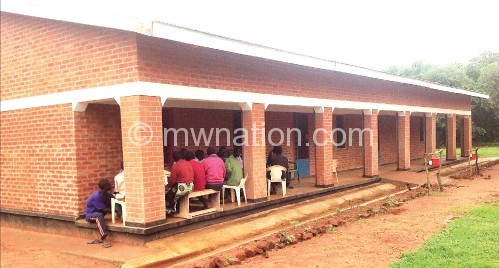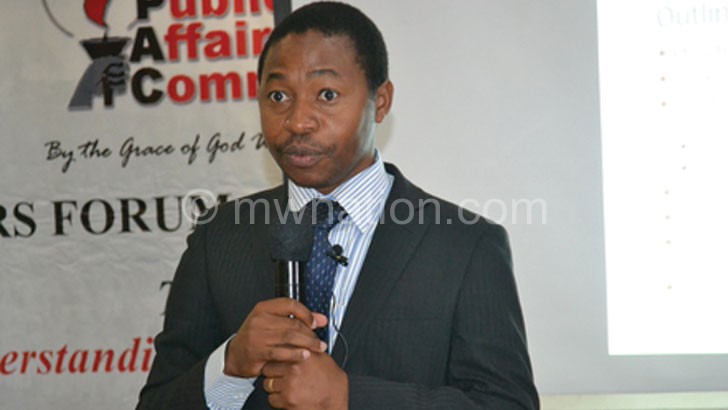Can Ministry of Education’s bold move help return LDF to original design?

They are there—the skeletons of a failed project parachuted into a community from Capital Hill without the involvement of either the district council or beneficiaries.
Under the weight and cloud of alleged corruption, the contractor hired by the Ministry of Education abandoned the project—a classroom block—before it was even roofed.
The community just watched. They still do so today even as the poster victim of the K187 million education scam crumbles at Nkumba Primary School in Mchinji, roughly 7km east of Kamwendo Trading Centre.
That money is worth nearly K2 billion today if you multiply the then lost amount in United States dollars ($4.2 million) by the current exchange rate of around K450.
Malawi Government lost the money over 15 years ago through full payments to contractors who never finished their works and via inflated quotations as well as shoddy workmanship.
At present unit costs of K9.9 million as per Local Development Fund (LDF) costing, K2 billion would construct over 200 school blocks complete with desks.
But today, adjacent to the abandoned structure at Nkumba Primary School is a similar classroom block funded by the same ministry under the Education Sector Wide Approach (ESWAp).
It was completed in six months between August 2012 and January 2013. The quality of the structure speaks volumes about what an empowered and motivated community can do if well mobilised, trained and supervised.
On this school block, like most school blocks and teachers’ houses sprouting at primary schools nationwide under LDF coordination, the ministry did not manage the process itself.
To achieve the strong results, the ministry leveraged competences of the LDF mechanism, which uses community management implementation arrangements in which resources are transferred directly to beneficiaries through councils to hire a local contractor, procure materials for construction and manage implementation.
Under LDF, communities’ democratically elected Project Management Committees (PMCs) are provided with the prerequisite training in project management, procurement and are left to manage projects, with councils backstopping them.
Genesis of ESWAp in LDF
The Ministry of Education’s 2010 Country Status Report (CSR) on education found that Malawi was off track on the sector’s Millennium Development Goals—universal primary completion and gender equity at all levels of education.
Among other major hindrances to achievement of the education goals was inadequate school infrastructure.
Thus, when government and donors moved to address problems affecting outcomes in the sector through a basket funding, construction and rehabilitation of school infrastructure was also prioritised.
In the first fiscal year of implementation (2009/10), the Ministry of Education centrally managed the infrastructure construction. But the initiative grossly under-performed, according to a 2009 Education Sector Performance Report.
For example, says the report, government planned to construct 1 430 classroom blocks for the primary education sector and 160 for the secondary education sector.
Of these, only 544 classroom blocks were constructed in the primary sector and 32 in the secondary sector, representing 38 percent and 26 percent success rates respectively.
LDF’s high success rate
But a similar project coordinated by LDF—with funding from government and the World Bank under MASAF3 Adaptable Programme Lending (APL) II—had a more impressive success rate.
Under LDF—whose implementing partners are councils and communities— government planned to construct 1 000 teachers’ houses in 2009/10; it managed to build 970, representing 97 percent success rate.
The fund was also successful with 141 other sub-projects in the education sector.
Of these, 53 involved construction of new classroom blocks, 20 entailed rehabilitation of old ones and 10 involved completion of classroom blocks from other troubled programmes, particularly the Constituency Development Fund (CDF).
In addition, 100 classroom blocks and 86 staff houses were constructed in Karonga and Chitipa in two financial years as part of the Crisis Response reconstruction programme for schools damaged by the earthquake.
Indeed, joint portfolio performance reviews of the World Bank lending in Malawi have consistently shown that LDF, previously Malawi Social Action Fund, was the country’s most efficient, fast disbursing and transparent mechanism.
The success rates of LDF projects were so impressive that donor partners agreed to a government request to invite the fund to participate in the construction of school blocks, teachers’ houses and other related education infrastructure to complement efforts by the Education Infrastructure Unit (EIMU) of the Ministry of Education.
Thus, in 2012/13, ESWAp entrusted LDF Technical Support Team (TST) with $30 million (K5.5 billion then, which is K13.5 billion using today’s exchange rate) to construct 1100 classrooms, 200 teachers’ houses and 350 VIP latrines.
Of the K5.5 billion, 95 percent was sent to councils and communities while LDF-TST retained five percent for programe support, which includes supervision, monitoring, procurement of cement blocks making moulds and buying of motor cycles.
Thanks to its respected fiduciary management arrangements, the LDF TST is set to beat the unit targets, according to a progress report we have seen.
The fund now expects to facilitate building of 1 222 classrooms, 207 teachers’ houses and 407 VIP latrines, thereby surpassing the targets by 10 percent, two percent and 16 percent respectively.
As of this month, 836 out of 1 122 classrooms were completed, representing 75 percent so far.
Further, 178 out of 207 teachers’ houses were completed, translating in 86 percent success rate at this stage.
Almost all VIP latrines have been finalised. By April this year, LDF expects to complete all the projects.
But what brings LDF the success rates that other government-linked local level infrastructure initiatives can only dream of?
The answer, says group village head Nkumba of Mchinji, lies in the design of the LDF that is anchored by local empowerment and community ownership principles within the context of decentralisation.
Indeed, the LDF’s beauty is that it is designed as part of the country’s fiscal decentralisation for quick disbursement of discretionary public financing grant facility.
“We used to hear about ‘power to the people’, but experienced none. How could we when everything, including projects in our own village, was so centralised? We were just on the receiving end.
“The LDF has given us real power. We identify a service gap, apply to the council for financing, hire a contractor and procure materials ourselves. As such, these projects are truly ours. Our contribution of bricks and sand to the projects guarantees our ownership of the projects and commitment to ensuring that it is completed on time, on budget and to specifications,” said GVH Nkumba in an interview.
At Kafantandala Primary School, T/A Chikho, in Ntchisi, head teacher Linkson Wakutchire explains with wonder how personally connected communities around the school are to the staff house they built with LDF funding.
“There is a feeling in the communities that this is their staff house built for their head teacher,” says Wakutchire, a beneficiary of the solar-powered staff house that is the area’s only source of electricity.
Which way, then?
But can the LDF’s ESWAp success help to convince ministries and donors that the fund should return to its original design of a standardised basket for local level investments into which all sectors should pour allocations targeted at communities? That is the billion kwacha question.
There is no doubt that LDF has departed from the original path. From the outset, the establishment of LDF was a response to the Paris Declaration on Aid Effectiveness and the Accra Agenda for Action.
Both advocate for harmonisation of development aid approaches and alignment of such towards a country’s own policy and implementation frameworks.
This is why, while the LDF National Policy Framework of 2009 prescribed two financing modalities, the ultimate—but now long forgotten goal—was basket funding.
The basket fund modality is non-discreet financing through LDF where interested development partners and government pool resources into a common pool for local councils’ budget support.
Its opposite is earmarked funding, which was actually a transitional financing modality available to donors at LDF’s inception to pool their resources into the basket fund but for specific ring-fenced projects.
The earmarks arrangement was supposed to be applied up to December 31 2011 after which donors who were earmarking projects would join others pooling their resources into a ‘colourless’ basket fund as preferred by government: the LDF.
But instead of progressing towards a basket mechanism, LDF appears to be pumped with earmarks both from the champion, government, and donors, leading to the gradual death of what used to be the LDF’s open menu—general funds for community demand driven (CDD), not centrally defined, projects that would help improve service delivery and alleviate poverty.
But as a Malawi Institute of Management (MIM) sector budget review study shows, development partners remain averse to the basket mode, preferring earmarks, which piles work on council officials through multiple reporting requirements.
“It is clear from the review that the disjointed funding mechanisms of development projects at local council exert enormous pressure on the limited personnel at the local council in terms of administration, supervision, monitoring and reporting for results on development projects. The same personnel are confronted with different financial and accounting as well as technical reporting requirements which result in duplication of effort.
“Through the LDF mechanism, such reporting requirements would be harmonised and streamlined, thereby bringing efficiency gains in the productivity of the existing personnel. In fact, this is the mode that the Malawi Government wants all donors to gradually shift to,” recommends MIM.
So, will the LDF’s effective management of the portion of the ESWAp initiative attract more devolved sectors that are sending less and less money to councils these days for development projects find a worthy partner in the LDF?
Based on evidence, they should. But is the centre ready to shed its obsession with fiscal and political power to the local level to achieve more sustainable service delivery?
The jury, as they say, is still out there.





